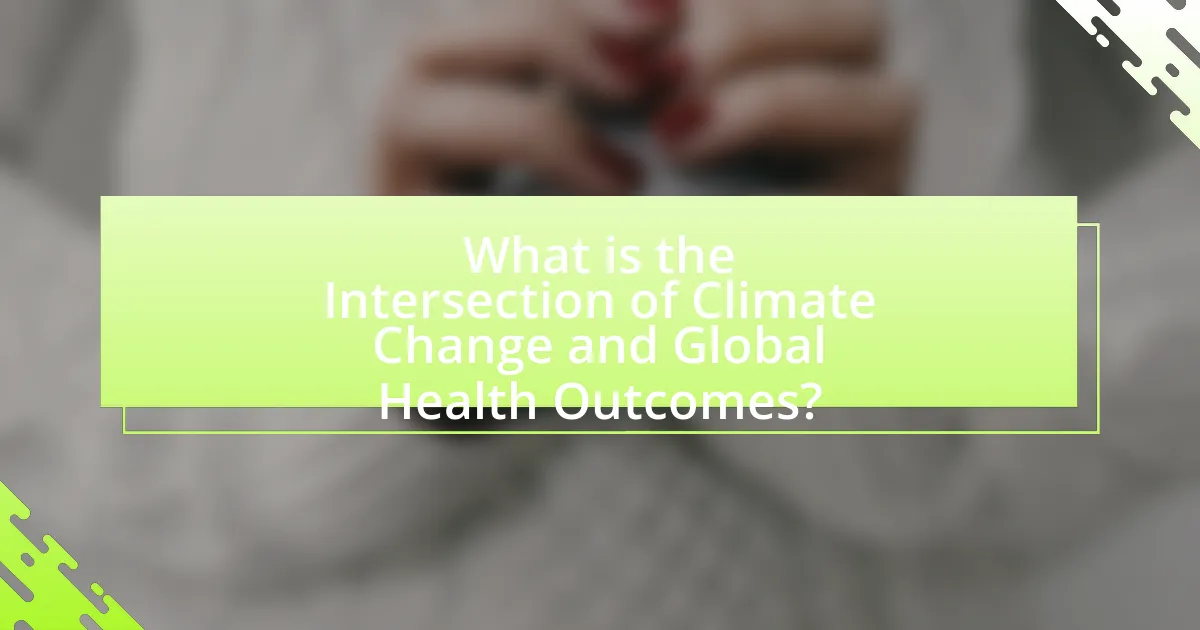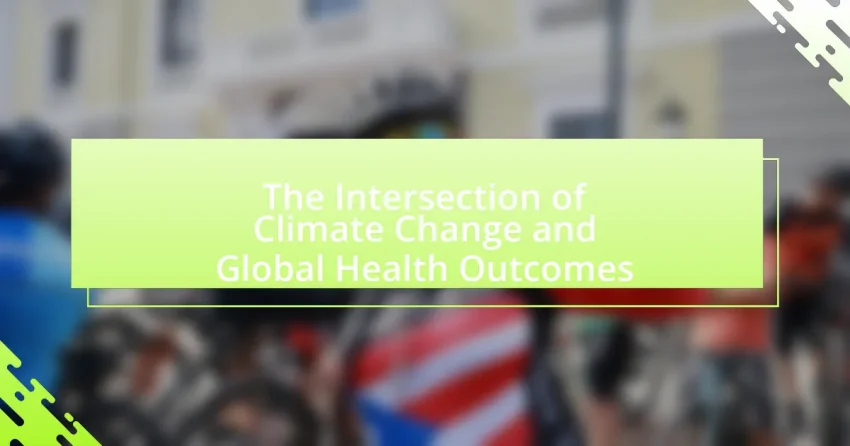The article examines the critical intersection of climate change and global health outcomes, highlighting the significant impacts of climate change on public health, including increased morbidity and mortality rates. It discusses how climate change contributes to the spread of infectious diseases, exacerbates respiratory and cardiovascular conditions, and leads to food and water insecurity, with the World Health Organization estimating an additional 250,000 deaths annually between 2030 and 2050 due to related health issues. The article emphasizes the importance of understanding this relationship for developing effective public health strategies and policies, addressing both climate mitigation and health promotion, and outlines the implications for healthcare systems and vulnerable populations. Additionally, it explores strategies for enhancing resilience and the role of individuals and communities in mitigating health impacts associated with climate change.

What is the Intersection of Climate Change and Global Health Outcomes?
The intersection of climate change and global health outcomes is characterized by the significant impact that climate change has on public health, including increased morbidity and mortality rates. Climate change contributes to the spread of infectious diseases, exacerbates respiratory and cardiovascular conditions due to air pollution, and leads to food and water insecurity, which can result in malnutrition and related health issues. For instance, the World Health Organization estimates that climate change is expected to cause an additional 250,000 deaths per year between 2030 and 2050 due to malnutrition, malaria, diarrhea, and heat stress. This evidence underscores the critical relationship between environmental changes and health outcomes, highlighting the need for integrated approaches to address both climate and health challenges.
How does climate change impact global health?
Climate change significantly impacts global health by increasing the frequency and severity of extreme weather events, which leads to injuries, fatalities, and mental health issues. For instance, the World Health Organization estimates that climate change will cause an additional 250,000 deaths per year between 2030 and 2050 due to malnutrition, malaria, diarrhea, and heat stress. Furthermore, rising temperatures and changing precipitation patterns contribute to the spread of infectious diseases, as seen with the expansion of vector-borne diseases like malaria and dengue fever into new regions. Additionally, air pollution from climate change exacerbates respiratory and cardiovascular diseases, leading to increased healthcare costs and reduced quality of life.
What are the direct health effects of climate change?
Climate change directly affects health by increasing the frequency and severity of heat-related illnesses, respiratory issues from poor air quality, and the spread of infectious diseases. For instance, rising temperatures can lead to heat exhaustion and heatstroke, particularly among vulnerable populations such as the elderly. Additionally, climate change contributes to air pollution, which exacerbates conditions like asthma and chronic obstructive pulmonary disease (COPD). Furthermore, changing weather patterns can expand the habitats of vectors like mosquitoes, increasing the incidence of diseases such as malaria and dengue fever. According to the World Health Organization, climate change is expected to cause an additional 250,000 deaths per year between 2030 and 2050 due to these direct health impacts.
How does climate change influence the spread of diseases?
Climate change influences the spread of diseases by altering environmental conditions that affect pathogen transmission and vector populations. For instance, rising temperatures and changing precipitation patterns can expand the habitats of disease-carrying organisms, such as mosquitoes and ticks, leading to increased incidences of diseases like malaria and Lyme disease. A study published in the journal “Nature” found that climate change has already contributed to the geographic spread of these vectors, with warmer climates facilitating their migration into new areas where they were previously absent. Additionally, extreme weather events, such as floods and droughts, can disrupt sanitation and water supply, further increasing the risk of waterborne diseases.
Why is understanding this intersection important?
Understanding the intersection of climate change and global health outcomes is crucial because climate change significantly impacts public health, leading to increased morbidity and mortality rates. Research indicates that rising temperatures and extreme weather events exacerbate health issues such as respiratory diseases, heat-related illnesses, and vector-borne diseases. For instance, the World Health Organization estimates that climate change will cause an additional 250,000 deaths per year between 2030 and 2050 due to malnutrition, malaria, diarrhea, and heat stress. This intersection is vital for developing effective public health strategies and policies that address both climate mitigation and health promotion, ensuring a comprehensive approach to safeguarding population health in the face of environmental changes.
What are the implications for public health policy?
The implications for public health policy regarding the intersection of climate change and global health outcomes include the necessity for adaptive strategies to mitigate health risks associated with climate-related events. Public health policies must prioritize the integration of climate data into health planning, as evidenced by the World Health Organization’s report indicating that climate change could cause an additional 250,000 deaths annually between 2030 and 2050 due to malnutrition, malaria, diarrhea, and heat stress. Furthermore, policies should focus on enhancing healthcare infrastructure to withstand climate impacts, promoting sustainable practices to reduce greenhouse gas emissions, and ensuring equitable access to health resources for vulnerable populations. These measures are essential to address the direct and indirect health effects of climate change effectively.
How can awareness of this intersection drive action?
Awareness of the intersection of climate change and global health outcomes can drive action by motivating individuals and organizations to implement sustainable practices that mitigate climate impacts on health. For instance, understanding that rising temperatures can exacerbate respiratory diseases encourages policymakers to prioritize air quality regulations. Research from the World Health Organization indicates that climate change could cause an additional 250,000 deaths annually between 2030 and 2050 due to malnutrition, malaria, and heat stress, highlighting the urgency for integrated health and environmental policies. This awareness fosters collaboration across sectors, leading to innovative solutions that address both climate and health challenges effectively.

What are the key factors linking climate change and health outcomes?
The key factors linking climate change and health outcomes include increased frequency of extreme weather events, air quality deterioration, and the spread of infectious diseases. Extreme weather events, such as hurricanes and heatwaves, lead to injuries, fatalities, and mental health issues, as evidenced by the World Health Organization reporting that climate-related disasters have caused over 4.5 million deaths globally between 2000 and 2019. Deteriorating air quality, primarily due to increased greenhouse gas emissions, exacerbates respiratory and cardiovascular diseases; for instance, the American Lung Association states that air pollution contributes to approximately 100,000 premature deaths annually in the United States. Additionally, climate change alters ecosystems, facilitating the spread of vector-borne diseases like malaria and dengue fever, with the Lancet Countdown on Health and Climate Change indicating that rising temperatures could increase the population at risk for these diseases by millions.
How do environmental changes affect health systems?
Environmental changes significantly impact health systems by altering disease patterns, increasing healthcare demands, and straining resources. For instance, rising temperatures and changing precipitation patterns can lead to the spread of vector-borne diseases, such as malaria and dengue fever, which burden health systems with increased patient loads and necessitate enhanced surveillance and response strategies. Additionally, extreme weather events, such as hurricanes and floods, can disrupt healthcare infrastructure, limit access to services, and exacerbate health disparities. According to the World Health Organization, climate change is expected to cause an additional 250,000 deaths per year between 2030 and 2050 due to malnutrition, malaria, diarrhea, and heat stress, highlighting the urgent need for health systems to adapt and respond effectively to these environmental changes.
What role does air quality play in health outcomes?
Air quality significantly impacts health outcomes by influencing respiratory and cardiovascular diseases. Poor air quality, characterized by high levels of pollutants such as particulate matter and nitrogen dioxide, has been linked to increased hospital admissions and premature deaths. For instance, the World Health Organization estimates that air pollution causes approximately 7 million deaths annually, primarily due to conditions like asthma, chronic obstructive pulmonary disease, and heart disease. Studies have shown that long-term exposure to polluted air can lead to reduced lung function and increased incidence of lung cancer, highlighting the critical role air quality plays in determining overall health.
How does water scarcity impact health?
Water scarcity significantly impacts health by increasing the risk of waterborne diseases and malnutrition. Limited access to clean water leads to inadequate sanitation and hygiene practices, which can result in the spread of diseases such as cholera and dysentery. According to the World Health Organization, approximately 2 billion people lack access to safe drinking water, contributing to over 500,000 deaths annually from diarrheal diseases. Furthermore, water scarcity can hinder agricultural productivity, leading to food shortages and malnutrition, particularly in vulnerable populations. This interplay between water scarcity and health outcomes underscores the critical need for sustainable water management in the context of climate change.
What vulnerable populations are most affected?
The vulnerable populations most affected by climate change include low-income communities, indigenous peoples, the elderly, children, and individuals with pre-existing health conditions. These groups often lack the resources to adapt to climate-related changes, such as extreme weather events, food insecurity, and health risks. For instance, according to the Intergovernmental Panel on Climate Change (IPCC), marginalized communities are disproportionately impacted due to their limited access to healthcare, safe housing, and economic opportunities, which exacerbates their vulnerability to climate-related health issues.
How does socioeconomic status influence health risks?
Socioeconomic status significantly influences health risks by determining access to resources, healthcare, and living conditions. Individuals with lower socioeconomic status often experience higher rates of chronic diseases, mental health issues, and limited access to preventive care. For instance, a study published in the American Journal of Public Health found that people in lower income brackets are more likely to suffer from conditions such as diabetes and hypertension due to factors like inadequate nutrition and lack of healthcare access. Additionally, environmental factors associated with lower socioeconomic status, such as living in areas with higher pollution levels, further exacerbate health risks.
What geographic areas are at the highest risk?
The geographic areas at the highest risk due to climate change include low-lying coastal regions, such as Bangladesh and the Maldives, as well as arid regions like sub-Saharan Africa. These areas are particularly vulnerable to rising sea levels, extreme weather events, and droughts, which can exacerbate health issues. For instance, according to the Intergovernmental Panel on Climate Change (IPCC), coastal regions are projected to experience significant flooding and displacement, while sub-Saharan Africa faces increased food insecurity and water scarcity, leading to health crises.

What strategies can mitigate the health impacts of climate change?
Strategies that can mitigate the health impacts of climate change include enhancing public health infrastructure, promoting sustainable agriculture, and increasing access to clean water and sanitation. Strengthening public health systems enables better preparedness and response to climate-related health threats, such as heatwaves and vector-borne diseases. For instance, the World Health Organization emphasizes the need for robust health systems to manage the increased burden of diseases linked to climate change. Sustainable agricultural practices can reduce greenhouse gas emissions while ensuring food security, which is crucial as climate change affects crop yields. Additionally, improving access to clean water and sanitation can prevent waterborne diseases that are exacerbated by climate-related flooding and droughts. According to the Intergovernmental Panel on Climate Change, these strategies are essential for reducing vulnerability and enhancing resilience against the health impacts of climate change.
How can healthcare systems adapt to climate change?
Healthcare systems can adapt to climate change by implementing strategies that enhance resilience and sustainability. These strategies include integrating climate considerations into health planning, improving infrastructure to withstand extreme weather events, and enhancing disease surveillance systems to monitor climate-related health impacts. For instance, the World Health Organization emphasizes the need for health systems to develop climate adaptation plans that address vulnerabilities, such as increased heat-related illnesses and vector-borne diseases. Additionally, investing in training healthcare professionals on climate-related health issues can improve response capabilities. Evidence shows that countries with proactive health adaptation strategies, like the Netherlands, have successfully reduced health risks associated with climate change, demonstrating the effectiveness of such approaches.
What practices can improve resilience in health systems?
Practices that can improve resilience in health systems include enhancing data collection and analysis, strengthening supply chain management, and fostering community engagement. Enhanced data collection allows health systems to better predict and respond to climate-related health threats, as evidenced by the World Health Organization’s emphasis on data-driven decision-making in its 2021 report on climate and health. Strengthening supply chain management ensures that essential medicines and resources are available during crises, which is critical during extreme weather events, as highlighted by the 2020 Global Health Security Index. Community engagement fosters local ownership and preparedness, which has been shown to improve health outcomes in vulnerable populations, according to research published in the Lancet in 2019.
How can technology aid in addressing health impacts?
Technology can aid in addressing health impacts by enabling real-time data collection and analysis, which enhances disease surveillance and response. For instance, mobile health applications and wearable devices allow for continuous monitoring of health metrics, facilitating early detection of health issues related to climate change, such as heat-related illnesses. Additionally, telemedicine platforms improve access to healthcare services, particularly in remote areas affected by climate-related disruptions. According to a study published in the journal “Environmental Research Letters,” the integration of technology in public health initiatives has been shown to improve health outcomes by 30% in communities facing environmental challenges.
What role do individuals and communities play in this issue?
Individuals and communities play a crucial role in addressing the intersection of climate change and global health outcomes by actively participating in mitigation and adaptation efforts. Their actions, such as reducing carbon footprints through sustainable practices, can significantly lower greenhouse gas emissions, which are linked to health issues like respiratory diseases and heat-related illnesses. For instance, a study published in the journal “Environmental Health Perspectives” highlights that community-led initiatives in urban areas can reduce air pollution levels, thereby improving public health outcomes. Additionally, communities can advocate for policies that promote environmental justice and equitable access to healthcare, ensuring that vulnerable populations are protected from the adverse effects of climate change.
How can community engagement enhance health outcomes?
Community engagement can enhance health outcomes by fostering collaboration between health organizations and local populations, leading to tailored health interventions that address specific community needs. Engaged communities are more likely to participate in health programs, resulting in increased awareness and adherence to health guidelines. For instance, a study published in the American Journal of Public Health found that community-based participatory research significantly improved health outcomes in underserved populations by involving them in the decision-making process. This approach not only empowers individuals but also builds trust, which is crucial for effective health communication and intervention.
What actions can individuals take to reduce their impact?
Individuals can reduce their impact on climate change by adopting sustainable practices such as reducing energy consumption, minimizing waste, and choosing eco-friendly transportation options. For instance, using energy-efficient appliances can lower household energy use by 10-50%, significantly decreasing carbon emissions. Additionally, individuals can reduce waste by recycling and composting, which diverts approximately 30% of waste from landfills, thereby reducing methane emissions. Opting for public transport, biking, or walking instead of driving can cut personal carbon footprints by up to 45%, as transportation accounts for about 29% of total greenhouse gas emissions in the United States. These actions collectively contribute to mitigating climate change and improving global health outcomes by reducing air pollution and promoting a healthier environment.
What are best practices for addressing the intersection of climate change and health?
Best practices for addressing the intersection of climate change and health include integrating climate considerations into public health policies, promoting sustainable practices, and enhancing community resilience. Public health policies should incorporate climate data to anticipate health risks, such as heat-related illnesses and vector-borne diseases, which are projected to increase due to climate change. For instance, the World Health Organization reports that climate change could cause an additional 250,000 deaths per year between 2030 and 2050 from malnutrition, malaria, diarrhea, and heat stress. Promoting sustainable practices, such as reducing greenhouse gas emissions through renewable energy and sustainable agriculture, can mitigate climate impacts while improving health outcomes. Additionally, enhancing community resilience through education and infrastructure improvements can prepare populations for climate-related health challenges, as evidenced by successful adaptation strategies implemented in various regions worldwide.
